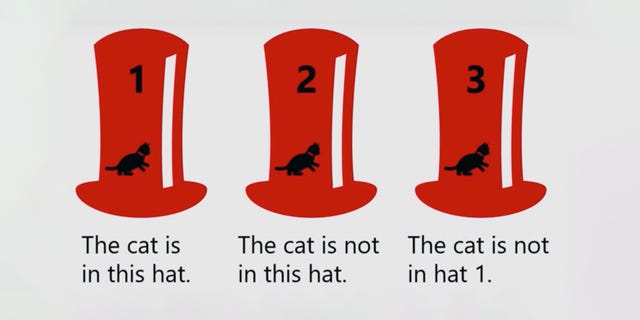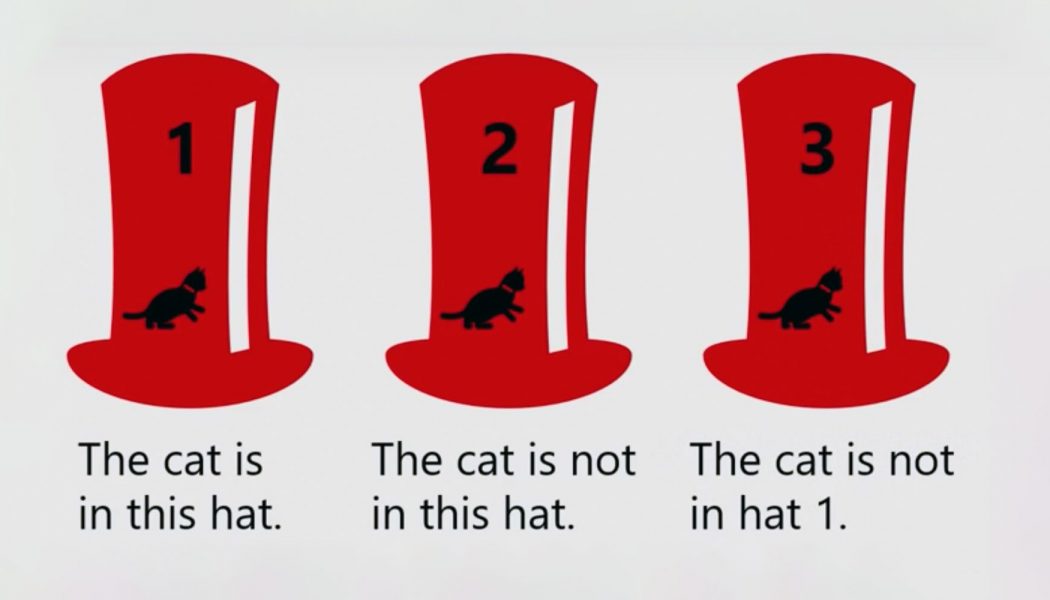
YouTube/Mind Your Decisions
- This logic test about a cat in a hat stumps most people—but will it confuse you?
- Watching the problem play out in this video is helpful in understanding it.
- Want more brainteasers? You’ve come to the right place.
A survey found only 36 percent of people could find the right answer to a seemingly simple logic problem, according to economics and math pro Presh Talwalkar of the YouTube channel Mind Your Decisions.
➗ You love challenging math problems. So do we. Let’s solve them together.
Here’s the problem:
“There are three hats, each with an accompanying statement.
Hat One: The cat is in this hat.
Hat Two: The cat is not in this hat.
Hat Three: The cat is not in Hat One.
Exactly one of the statements is true. Exactly one hat contains a cat. Which hat contains the cat?”
The answer options are: 1) Hat One; 2) Hat Two; 3) Hat Three; 4) None of the hats; or 5) Not enough information.
Okay, so maybe this problem isn’t as simple as it seems. But thankfully, Talwalkar broke down how to solve the logic problem in a new YouTube video.
This content is imported from {embed-name}. You may be able to find the same content in another format, or you may be able to find more information, at their web site.
This content is imported from YouTube. You may be able to find the same content in another format, or you may be able to find more information, at their web site.
So, what is the correct answer?
Well, first, you have to logically consider each case, assuming the cat is in each hat, then seeing if each statement applies to that case. If you end up with one true statement and two false statements, you have the correct cat-in-hat placement.
Let’s assume the cat is in Hat One. Hat One’s statement is obviously true in this scenario. But if the cat is in Hat One, the cat would not be in Hat Two, making the second statement also true. This means the cat is not in Hat One because if it was, two statements would be true—and that clearly doesn’t satisfy the conditions of the problem.
Well, what if we assume the cat is in Hat Three? Hat Three’s statement would then be true, while Hat One’s statement would be false. So far, so good for only one true statement in the bunch. But the issue comes when considering Hat Two’s statement: The cat is not in Hat Two. That would also be true, assuming the cat were in Hat Three. With two true statements, this isn’t the right answer.
Spoiler Alert: The cat is in Hat Two—and here’s why. Assuming the cat is in Hat Two, the statement corresponding with that hat is false. In addition, the first statement is also false, as the cat is in Hat Two, not Hat One. The true statement then is Hat Three’s statement. The cat is not in Hat One. This answer satisfies the confusion conditions of the problem, putting the cat in Hat Two with the correct statement being that of Hat Three.
Trust us: Watching the problem play out in Talwalkar’s video is helpful in understanding this complex logic test. The math pro says most people run into trouble assuming the cat must be in a hat where the statement is true. But that’s obviously not the case. The two need to be thought as independent conditions to solve the problem correctly.
That said, we’d just pick up each hat until we found the damn cat, but that’s probably not as impressive.
Now Watch This:
This content is created and maintained by a third party, and imported onto this page to help users provide their email addresses. You may be able to find more information about this and similar content at piano.io
Join Our Telegram Group : Salvation & Prosperity












